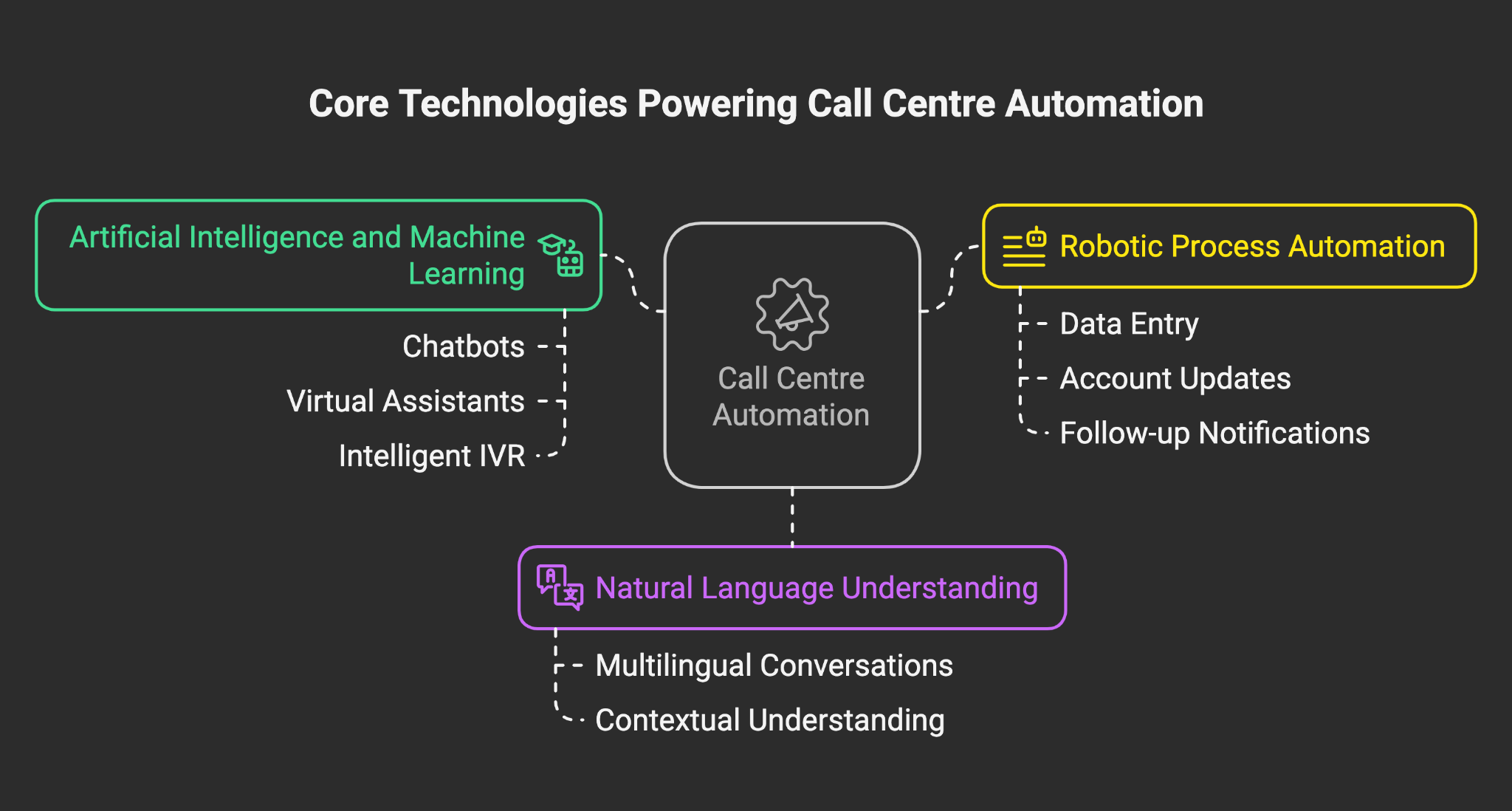Automation in the call centre is quietly solving the pain points that have limited efficiency for years. There is a new generation of call centre automation solutions out there, and they’re helping businesses reshape the way support happens.
Call centres have always been the frontlines of customer engagement, but their role is quickly changing with the rise of smart automation. When agents spend most of their time on repetitive calls or data entry, it leaves little room for genuine customer connections.
For instance, a retail call centre where customers keep calling to check delivery updates. Now, an automated voice assistant can quickly share order status, letting human agents step in only when there’s a lost package or a customer needs special assistance.
Let’s take a closer look at what’s changing.
What is Call Centre Automation?
Call centre automation is the process of using advanced technology to streamline and improve daily operations within a call centre. Instead of relying on human agents for every routine question, automation tools handle repetitive tasks, answering common inquiries, routing calls to the right person, or completing data entry.
While traditional IVR (Interactive Voice Response) menus offer basic “press 1 for this, press 2 for that” options, modern call centre automation goes far beyond. AI-powered systems understand natural speech, solve issues without human help, and seamlessly escalate complex cases to live agents when needed. This makes today’s call centres faster, more consistent, and truly customer-focused, delivering smoother service than basic IVR alone ever could.
Core Technologies Powering Call Centre Automation
Building an efficient, automated call centre depends on the right blend of technologies. Below are the key building blocks that are reshaping the way contact centres operate:

- Artificial Intelligence and Machine Learning
AI engines and machine learning models are now embedded in most leading automation platforms. They power chatbots, virtual assistants, and intelligent IVR, helping these tools understand natural speech, learn from historical call patterns, and continually improve with every interaction. AI can also analyse sentiment and customer intent, making every automated response more relevant and effective.
Natural Language Understanding (NLU)
NLU is the technology behind systems that can interpret the meaning of spoken or typed language. With advanced NLU, virtual agents can understand the nuances of human requests, handle multilingual conversations, and carry context from one exchange to the next. This is especially valuable in markets with diverse languages and dialects, ensuring customers feel understood.
Robotic Process Automation (RPA)
These digital “robots” are designed to automate repetitive workflows such as entering data into a CRM, updating account records after each call, or sending follow-up notifications. By handling these administrative tasks automatically, RPA lets agents spend their time on genuine human support.
Types of Call Centre Automation Tools Shaping the Industry
Automation is reshaping the call centre landscape, bringing a variety of tools that simplify both customer and agent experiences. Here are the most influential types making an impact today:
- Intelligent Call Routing and Scheduling
Sophisticated call distribution systems use data and algorithms to match callers with the right agent based on skill, availability, or customer history. Predictive dialers automate outbound calls and ensure agents spend less time waiting and more time helping.
- AI-Powered Self-Service & Virtual Agents
Natural language chatbots and voice bots handle common queries around the clock, offering instant answers in multiple languages. Virtual agents like those built for India’s diverse audiences by Reverie’s Indocord enable businesses to deploy voice and chat agents that understand regional languages, making support more inclusive and accessible.
- Workflow & Back-Office Automation
Robotic process automation (RPA) and scripting tools handle after-call work, including automatically logging call details, updating records, and sending follow-up messages. This lightens the administrative burden on agents and reduces delays.
- Sales & Marketing Automation
CRM-driven solutions qualify leads, schedule callbacks, and trigger personalised offers based on customer data. These tools help ensure every sales opportunity is captured with minimal manual effort.
- Internal Messaging & Alerts
Automated notifications and internal communications keep agents and supervisors updated on urgent issues, schedule changes, or system alerts. This makes teamwork smoother and responses quicker during high-traffic periods.
Business Benefits of Automating Your Call Centre Operations
Automating call centre operations isn’t just about reducing workloads; it fundamentally changes how support teams deliver value. Here’s what businesses stand to gain:
- Enhanced Operational Efficiency
- Repetitive queries and routine workflows are handled swiftly, freeing agents for more critical problem-solving.
- Smart routing reduces wasted time, ensuring the right agent is available for each customer’s needs.
- Volume surges become easier to manage without overstaffing or compromising quality.
- Consistent processes help minimise errors and speed up average handling times.
- Elevated Customer Experience
- Customers enjoy shorter wait times and immediate resolutions for straightforward requests.
- Seamless handoffs between virtual agents and humans create a frictionless support journey.
- Self-service options empower customers to get help on their schedule, not just during business hours.
- Personalised service, driven by CRM data and AI insights, leaves customers feeling understood and valued.
- Reduced Operational Costs
- Self-service solutions and automation cut down on staffing requirements, especially for high-frequency, low-complexity tasks.
- Fewer manual interventions mean less overtime, fewer errors to fix, and lower training costs for new agents.
- Resource allocation becomes smarter, reducing unnecessary spending during slow periods.
- Improved utilisation of full-time agents leads to long-term savings.
- Deeper Data Insights and Continuous Improvement
- Every customer touchpoint is tracked, producing rich data for analytics and reporting.
- Managers can spot emerging trends, monitor performance, and adjust workflows in real time.
- Data-driven insights help fine-tune automation flows and agent scripts for better results.
- Continuous feedback loops support ongoing optimisation and innovation.
- Improved Employee Morale and Engagement
- Agents spend less time on monotonous work and more on challenging, rewarding conversations.
- Real-time “agent assist” features give them actionable information while on live calls.
- Lower burnout and higher job satisfaction contribute to lower turnover rates.
- Opportunities for learning new tools and processes create a more dynamic workplace.
Step-by-Step Guide to Implementing Call Centre Automation Successfully
Bringing automation into a call centre is a team effort and works best when changes happen step by step. It often starts with managers spotting where agents feel stretched or where customers experience delays.
The following are practical steps that reflect how successful teams put call centre automation in place and get lasting results:
Step: Start with a Thorough Assessment
Begin by mapping out current workflows, identifying the most repetitive or time-consuming tasks, and understanding where customer experience falls short. Involving agents and supervisors in this review brings out hidden pain points and practical opportunities for automation.
Step: Define Measurable Objectives
Set clear, actionable goals such as reducing average response times, boosting first-call resolution, or increasing customer satisfaction scores. These targets keep the project focused and provide a framework for evaluating progress at every stage.
Step: Select the Right Technology Partners
Carefully evaluate automation platforms and vendors, ensuring compatibility with your existing systems. Look for partners like Reverie that support multiple languages, compliance needs, and integrations your business requires. Prioritise solutions that offer flexibility for future upgrades or expansion.
Step: Pilot and Roll Out in Stages
Introduce automation gradually, starting with low-risk, high-impact tasks like FAQ chatbots or automated post-call surveys. Pilot programs allow you to collect feedback, iron out technical issues, and build support across the team before scaling up.
Reverie’s Call Centre Automation Solutions for India’s Diverse Customer Base
For call centres in India, multilingual support is more than a feature; it’s essential for reaching customers in their own language, wherever they are. Reverie’s multilingual Voice AI Agents use conversational AI, natural language understanding, and speech recognition, so callers feel comfortable and understood right from the first “hello.”
With our Voice AI Agents, companies can automate everyday inquiries and route complex issues to the right agents. Teams can also personalise responses based on region or context, all through a no-code platform that anyone can adapt without technical expertise.
Key highlights of Reverie’s approach:
- Multilingual voice agents that speak your customers’ language
- Quick, code-free setup and easy integration with existing systems
- Real-time sentiment analysis and contextual responses for higher satisfaction
- Secure, compliant handling of customer data for regulated sectors
Conclusion
For call centres, automation is now a core strategy for delivering reliable, fast support and building stronger customer loyalty. Adopting the right solution makes all the difference, especially in a country where every region brings new languages and expectations.
Reverie helps contact centres connect better, respond faster, and adapt with less effort. If you are interested in seeing how IndoCord works in real customer scenarios, reach out to book a free demo with Reverie today!
Faqs
How does call centre automation improve operational efficiency?
Call centre automation streamlines repetitive tasks, such as call routing and data entry, so agents handle more complex requests. This reduces wait times, minimises errors, and allows teams to manage higher call volumes without increasing staff.
What technologies drive modern call centre automation?
Modern automation uses AI, natural language processing, speech recognition, and RPA. These technologies enable virtual agents to interact naturally, handle multilingual requests, and automate workflows, resulting in faster, more consistent customer support.
How can businesses support multilingual customers through automation?
Solutions like Reverie’s IndoCord deploy AI-powered voice and chat agents in multiple Indian languages. Businesses use IndoCord to provide local-language support, personalise customer journeys, and reach wider markets without extra staffing or complex IT.
How does automation impact customer satisfaction in call centres?
Automation ensures customers receive quick, consistent answers to routine queries, even outside business hours.
Why choose a no-code platform like IndoCord for call centre automation?
IndoCord enables teams to launch and update automation flows quickly, without technical expertise.

